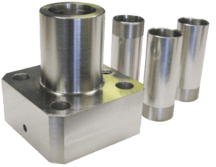About Electroless Nickel Plating
Electroless nickel plating is renowned for delivering a uniform coating without electrical current, setting it apart from traditional electrolytic methods like chromium or nickel plating. This process ensures consistent coverage on complex geometries, including blind holes, threads, channels, recesses, internal surfaces, sharp corners, edges, and flat surfaces.
With a plating thickness tolerance often maintained to less than 2 microns, electroless nickel delivers precision and reliability. While deposits can be machined, it’s often unnecessary due to the process’s inherent accuracy. In many applications, electroless nickel is an efficient and effective alternative to hard chromium, offering comparable durability and performance.
Ready to get started? Contact us today.
 Hardness & Wear of Electroless Nickel Plating
Hardness & Wear of Electroless Nickel Plating
Its hardness and wear resistance are two key properties that make electroless nickel ideal for many applications. In its as-plated form, electroless nickel achieves a hardness of 45-49 Rc (HV450-500). When heat-treated, it can reach an impressive hardness of 66-70 Rc (HV865-1050).
Its exceptional wear resistance makes electroless nickel a reliable alternative to high-alloy materials and hard chrome, providing superior performance in demanding applications.
Corrosion Resistance of Electroless Nickel
Electroless nickel is a highly effective barrier coating, sealing substrates to protect them from corrosive environments. Its exceptional corrosion resistance makes it ideal for exposure to ammonia, seawater, brine, and organic acids and for reducing inorganic acids.
These properties make electroless nickel an excellent choice for applications in the food, chemical, and oil industries and other demanding environments requiring robust protection and durability.
Electroless Nickel Standard
- MIL-C-26074: Class 1, 2, 3, and 4
- MIL-DTL-32119
- SAE AHS-C-2404
Electroless Nickel Plating in Round Rock, Texas
CMT offers high phosphorus electroless nickel plating with two processing tanks, each measuring 28 in. x 42 in. x 36 in., ensuring we can handle a wide range of parts and components for your specific needs.
